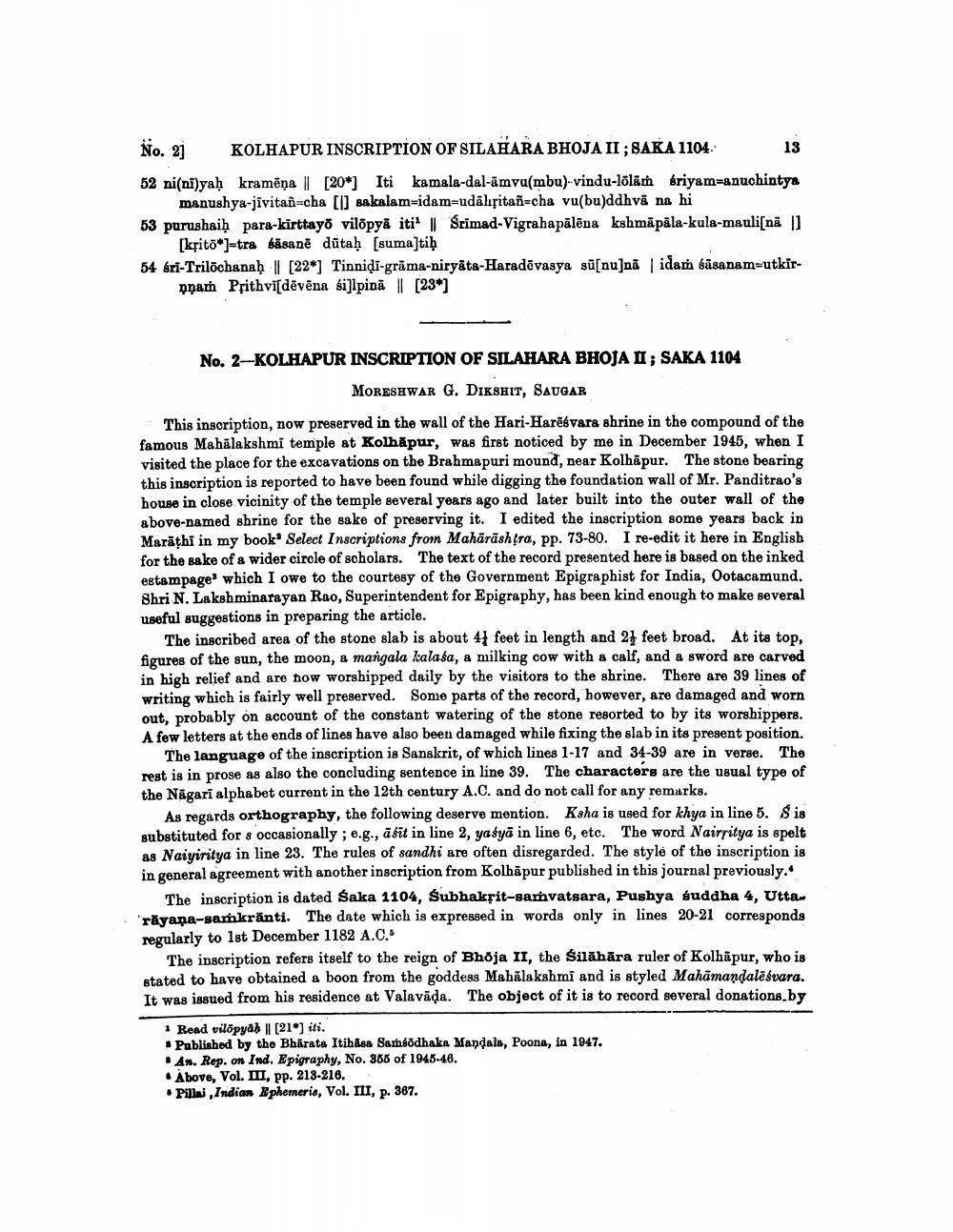________________
No. 21 KOLHAPUR INSCRIPTION OF SILAHARA BHOJA II ; SAKA 1104. 13 52 ni(ni)yaḥ kramēņa || [20*) Iti kamala-dal-āmva(mbu)-vindu-lõlām briyam=anuchintys
manushya-jivitan-cha [l] sakalam-idam=udāhsitan-cha vu(bu)ddhvā no hi 53 purushaiḥ para-kirttayo vilöpyä iti || Srimad-Vigrahapālēna kshmāpāla-kula-mauli[nā 1]
[ksito*]-tra bisaně dūtaḥ (suma]tiḥ 54 6ri-Trilochanaḥ || [22*) Tinnidi-grāma-niryāta-Haradēvasya sū[nu]nā | idam sāsanam=utkir
pņam Prithvi[dēvēna si]lpinā [23*]
No. 2-KOLHAPUR INSCRIPTION OF SILAHARA BHOJA II ; SAKA 1104
MORESHWAR G. DIKSHIT, SAUGAR
This inscription, now preserved in the wall of the Hari-Harēsvara shrine in the compound of the famous Mahālakshmi temple at Kolhapur, was first noticed by me in December 1945, when I visited the place for the excavations on the Brahmapuri mound, near Kolhapur. The stone bearing this inscription is reported to have been found while digging the foundation wall of Mr. Panditrao's house in close vicinity of the temple several years ago and later built into the outer wall of the above-named shrine for the sake of preserving it. I edited the inscription some years back in Marāthi in my book. Select Inscriptions from Mahārāshtra, pp. 73-80. I re-edit it here in English for the sake of a wider circle of scholars. The text of the record presented here is based on the inked estampage which I owe to the courtesy of the Government Epigraphist for India, Ootacamund. Shri N. Lakshminarayan Rao, Superintendent for Epigraphy, has been kind enough to make several useful suggestions in preparing the article.
The inscribed area of the stone slab is about 4 feet in length and 21 feet broad. At its top, figures of the sun, the moon, a mangala kalasa, a milking cow with a calf, and a sword are carved in high relief and are now worshipped daily by the visitors to the shrine. There are 39 lines of writing which is fairly well preserved. Some parts of the record, however, are damaged and worn out, probably on account of the constant watering of the stone resorted to by its worshippers. A few letters at the ends of lines have also been damaged while fixing the slab in its present position.
The language of the inscription is Sanskrit, of which lines 1-17 and 34-39 are in verse. The rest is in prose as also the concluding sentence in line 39. The characters are the usual type of the Nagari alphabet current in the 12th century A.C. and do not call for any remarks.
As regards orthography, the following deserve mention. Ksha is used for khya in line 5. Šis substituted for 8 occasionally ; e.g., āfit in line 2, yaśyā in line 6, etc. The word Nairritya is spelt as Naiyiritya in line 23. The rules of sandhi are often disregarded. The style of the inscription is in general agreement with another inscription from Kolhapur published in this journal previously.
The inscription is dated Saka 1104, śubhaksit-samvatsara, Pushya suddha 4, Utta. :rāyana-samkranti. The date which is expressed in words only in lines 20-21 corresponds regularly to 1st December 1182 A.C.
The inscription refers itself to the reign of Bhöja II, the Silāhāra ruler of Kolhapur, who is stated to have obtained a boon from the goddess Mahālakshmi and is styled Mahamandalesvara. It was issued from his residence at Valavāda. The object of it is to record several donations by
1 Read vilopyah (21) iti. • Published by the Bhkrata Itihisa Sambodhaka Mandala, Poona, in 1947.
An. Rep. on Ind. Epigraphy, No. 868 of 1945-46. • Above, Vol. III, pp. 213-216.
Pillai , Indian Ephemeris, Vol. III, p. 367.




